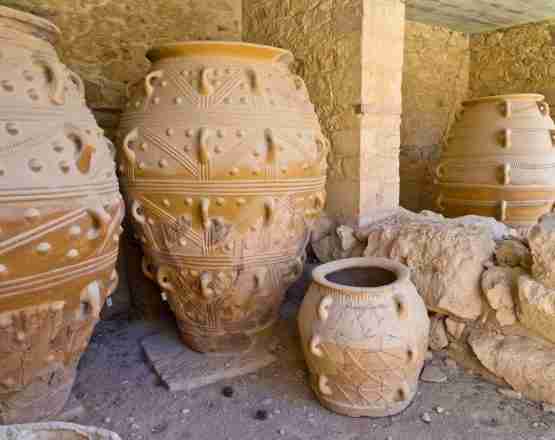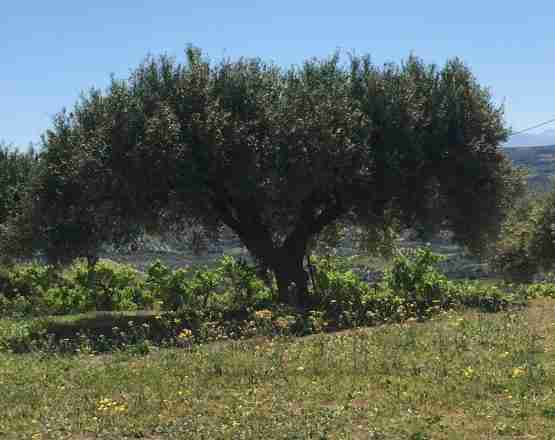MINOAN DIET, EATING AND LIFESTYLE
The diet of the Bronze Age people of Crete is surprisingly interesting and modern. Indeed, in some aspects it was even more exotic than what we today in Crete understand to be the traditional Cretan Mediterranean cuisine of the past century or two.
Based on the finds of the excavations and the analyses of the fragments of pottery and the remnants of plants, animals and seafoods, we know that the Minoans/Mycenaeans consumed for their everyday diet mainly pulses, cereals, olives and their oil, vine-fruits, and various vegetables/fruits/nuts; animals and to a lesser extent sea creatures provided protein.
This diet obviously is a healthy one for the heart and beneficial all round; they also led physically active lives to assist the process of fitness.
The physical remains of foodstuffs were identifiable from the early days of exploration. Only in the late 20 century though did advances in physics and chemistry provide scientists with the technology suitable to unlock and extract from this and other physical remains (like pottery) the evidence left behind and so to understand even more about their diet.
Zooarchaeology (that concerning animals) works with the bones and fragments of animal remains. Archaeobotany does the same with the remnants of all the plant kingdom. And radiocarbon dating provides us with the absolute timescale against which to measure and plot the rate of change and progress.
**************
Crete a large and mountainous island that developed both an agricultural and maritime economy as a result. Before the farmers were the hunter and gather peoples, whose presence is now everywhere to be seen through the mainland and islands of the Aegean. Franchthi (a cave in mainland Greece) has given us good evidence of these partly-wandering folk and evidence of the animals and fish they hunted. In Crete the evidence to date is mostly from the stone tools they left behind.
By 7000-6500 BC, the farming settlements in Crete are emerging. The entire package of plants and animals had to be brought physically across sea voyages of at least several hours duration. Knossos is their oldest settlement in Crete: situated beside a small river, some 5 kilometres from the sea, up on a hill with plenty of grazing and agricultural areas around it.
The choice of this hill area to reside on displays careful thought and good understanding and awareness of agricultural needs.
From this period, in the lowest stratum of Knossos comes evidence of cattle, pigs, emmer, wheat and barley. Unlocking their DNA will eventually give us some idea of the route by which they (humans, domesticates and plants) arrived on island. It is surmised that the Neolithic Knossians developed the idea of using oxen for traction, perhaps ploughing. This advance will have allowed them to till more land, and feed more mouths .. partly no doubt accounting for the sheer size Neolithic Knossos attained.
As cultivation became more systematic with the centuries, and as the technology of the people evolved, it is likely that small farms and hamlets spread across the landscape – rotating crops of pulses and cereals, intermingled with horticulture and arboriculture. Much as was still done in rural areas of Crete up to the very recent past. Sheep, goats, cattle, and pigs were kept for their meat, skins and eventually dairy products. And manure. Once dead, the carcasses of the animals also provided useful material from their hides, bones, sinews and horns. But, as in most cultures of the time, the killing of an animal is far more likely to occur as either a sacrifice and/or as food on special occasions only.
Wild animals of the land were hunted and consumed .. some, with time, were the descendants of escaped domesticates (the agrimi or wild goat, and wild boar); others may have been imported too (deer); yet more were native (badger). Migratory and native birds were available. Bees were farmed for wax and honey. The seas (or at least that part close to the shoreline) harvested on a local basis. Donkeys provided the first transport on land, other than the human; horses only really arrived with the Mainlanders.
As settlements grew, as food became more plentiful – we enter the Bronze Age of Crete.
Even so, it still took a millennium of development, settlement from overseas and exposure to the wider world (by trade rather than conquest) until the centralized and elite worlds of the palaces and their towns emerged .. oh so slowly. These sites – Knossos, Phaistos, Malia, Zakros, Chania and others too – became centres of powerful economic and political clout.
********************************
The Mediterranean diet
The term ‘Mediterranean diet’ is attributed to Ancel Keys, an American physiologist who tried to establish how eating habits and diet affected health. In 1951, Keys studied lipid levels of men in the rural areas of seven countries, including Finland, Yugoslavia, Greece, Holland, the USA and Japan.
Notably lower cholesterol levels were observed in countries such as Greece. The ‘Mediterranean’ was high in cereal consumption levels, olive oil and fish – and apparently linked to the relative absence of cardiovascular disease.
But we must also understand that the Mediterranean diet and its people vary: it is not the same throughout. Generally, the people of the Mediterranean eat less meat, fats, sugar and eggs than most Americans, but the Greeks use much more olive oil. More too than the Turks or the Italians: and the Cretans use more olive oil than the mainland Greeks.*
So the Mediterranean diet has certain local characteristics, but broadly it may be said to be:
Low in animal fats
Rich is vegetables and legumes
Low in animal protein
High in complex carbohydrates
The Greeks have a high level of olive oil consumption, approx.. 60 grams a day.
The vegetable fats consumed by the Cretans is 30 % higher than the average American and the saturated fat animal consumption fats 52 %t lower.
********************
THE OLIVE AND ITS OIL
Used neat for cooking, heating, lighting, polishing; in cosmetics and rituals. Used as a base for painting, colouring, bathing substances, and as a lubricant.
It was thus a versatile substance, and as such very important in trade. Homer called it ‘green gold’.
The olive trees today are probably off-springs of the wild olive Olea Chrysophylla, Olea Oleaster, or Olea Europea. Modern DNA studies will help unravel these strands. In Greece today the wild olive (Olea Oleaster) is still found, just as it was more than 4000 years ago.
We see so many paintings of this tree: on wall paintings, and decorating their pottery; on sealstones and stone vases – never mind the numerous myths connected with this shallow rooted, but strong and enduring tree!
The Minoans, like the Cretans today, enjoyed cold pressed olive oil. Virgin Olive oil.
The olive oil, once pressed, takes 3 months to ‘ripen’: to come to its full flavour.
An olive is 50 % water; 30% solids and 20% oil. Olive oil is a mixture of triglycerides, mono-unsaturated fatty acids. And other fatty acids as well. But olive oil also has sterols, pigments, waxes and alcohols: all these have therapeutic value, as well as being antioxidants. A complex little number!
Because of its high moisture content the fruit has to be processed at once after harvest, to avoid damage due to the action of enzymes.
The Ancient Egyptians, who were not so lucky with their olives, were greatly appreciative of the Keftiu (the Minoans) and their oil.
LEGUMES
An unsung part of the Mediterranean diet, they are hugely present on every excavation .. in many sorts, some not eaten by humans today, and some requiring careful processing. In fact the Mediterranean Triad (olive, cereal and vine products) should really be the Mediterranean Quartet!
CEREALS
Here too, the evidence from archaeology is considerable: and again many of their crops are out of favour in the modern world, being not heavy enough croppers. Emmer wheat was the staple, but also represented are einkorn, hulled barley, broom corn millet, oats and barley.
THE VINE AND ITS PRODUCE
>>>>>>>>>>>>>>>>>>>>>>>>>>>>>>>>>>>>>>>>>>>>>>>>>>>>>>>>>>>>>>>>>>>>>>>>>>>>>>>>>>>>>>>>>>>>>>>>>>>>>>>>>>>>>>>>>>>>>>>>>>>>>>>>>>>>>>>>>>>>>>>>>>>>>>>>>>>>>>>>>
ANIMALS
Olive oil was the main base of fat in the Minoan diet.
But from the excavations we see that the Bronze Age Cretans consumed meat regularly enough.
Sheep/goat were kept mainly for their wool and milk, not simply meat. The shepherding of these flocks (thanks to detailed records that have survived) is seen to match those of the mediaeval European monastic orders, who were also primarily interested in their fleeces.
Those slaughtered to be eaten sometimes seem to have been culled out from the flock, as undesirable in some way (say, partly deformed, or old), and so surplus to requirements.
The textile industry on Crete was one of their glories: and vitally important to the economy. Like the shepherds and their flocks, we can trace the process from fleece to exotic clothing; and we can see the sorts of fabric made on Minoan wall-frescoes and Egyptian tomb paintings: from kilt to massive carpet-like weavings. Spindlewhorls and various forms of loom weights are what we mostly find: textiles almost never.
Pigs were known, but relatively little utilized – in comparison to the other domesticates. Hunting the ferocious wild (feral) boars, for their tusks, looks to have been a way of demonstrating prowess, skill and bravery.
Cattle were in some ways unsung heroes. It was they who ploughed the land and kept the people in fields and food. In the late Bronze Age, they were often owned collectively by a village .. and were for work. Tylissos had 6 such, a common number; but Chania had 50!
Apart from traction and manure, and the recycling of cereal by-products, they too were valuable for their milk, and if slaughtered yielded a mass of meat, hides and do on. Their ritual role and symbolic value is well-known from Minoan art, and hinted at in the legends and myths too.
FISH AND MOLLUSCS
The earliest evidence so far of fishing in Greece is in Epirus (Bailey 1992), found in the cave of Klithi, dated between 15000 and 10000 BC: back in the hunting and gathering era. Franchthi cave yields evidence of an organized exploitation of tuna.
But the Bronze Age is full of examples of the impact the sea and its denizens had for the Minoans.
Fishing gear is limited to fishhooks of metal; though nets are portrayed on frescoes (and one has even been retrieved on Thera), and line/net sinkers made of folded strips of lead .. and some of the innumerable pierced weights of clay and stone retrieved. In art and in many media, fish, sea mammals (dolphins) and molluscs are used as motifs. The most complex of this pattern is seen in the ceramic Marine style.
A particular group of shellfish (murex) can be persuaded to yield a magnificent purple dye .. very expensive – the Tyrian purple of later years. Many establishments are suspected on Crete, but a certain one has been identified on the island of Chryssi. It was a notoriously smelly process!
Actual bones and such of sea creatures tend to be found in settlements close to the shore. What was collected (fish or mollusc) tended to be small, numerous and found close to the surf-line. Middle-size and very occasionally the larger deeper-sea fish (tuna) turn up. Shells and crabs provided a goodly haul .. being stewed up together in a sort of stew. (Snails were probably also so treated .. as they are today.) Very occasionally bits of shark skeletons are found, but they were more likely to be from accidental washing-ups of a dead one, than anything hunted.
We have extensive references to fish and oysters by Homer in the Iliad and the Odyssey and their consumption.
Odyssey xxii 383
But he found all the sort of them fallen in their blood in the dust, like fishes that the
fishermen have drawn forth in the meshes of the net into a hollow of the beach
from out the grey sea, and all the fish, some longing for the salt waves,
Are heaped up on the sand, and the sun shines forth and takes their life away;
So now the wooers lay heaped upon each other.
The Cephalopods
Squid and octopus are amongst the creatures portrayed in art (as is the Argonaut, so-called): they will certainly have been eaten: but the octopus has no bones (just is beak).
HERBS AND WILD GREENS
Crete is hugely blessed by its topography and its position. The native plant life is very rich: and a lot of it is edible, or has medicinal, aromatic or other worthwhile qualities (from a human point of view). Suffice it to say that 80-year old ladies across the island today can recall up to 80 types of edible chorta (greens) .. some easily recognizable to us .. wild asparagus and wild leek, for example. Many more are quite exotic to modern tastes.
Fennel/Dill ma-ra-tu-wo Marathon in Greece got its name from this plant.
Celery se-ri-no
Mint mi-ta
Caper ku-pa-ro
SPICES
These are only known – to date – from words written on the Late Bronze Age Linear B tablets .. many are loan words from the Levant, which was the source of many of these exotics.
Coriander ko-ri-ja-do-no and ko-ri-ja-da-na
Cumin ku-mi-no Possibly a Semitic word
Sesami Sa-sa-ma Another Semitic word (Sesami used today in Greek cooking and for making halvas a sweet)
cardamon ka-da-mi-ja
Ginger ko-no-a-po-te-ra
EXOTIC FRUITS
The palm takes the palm here: much used as a symbol, and the figs eaten and stored
po-ni-ki-jo (Minoan Recipe) From Zakros we find evidence of lamb cooked with figs!
*************************
At the height of their powers in the 17th and 16th centuries BC, the Minoans, as a trading and naval power in the Mediterranean, seem to have great cultural influence over on the Islanders and the rising early Greek speakers on the mainland.
We see depictions of them in wall paintings: some their own, others in Egypt.
Young and slender, a well-proportioned and handsome lively-looking people. The men lithe and very athletic with long thick hair, active and dressed in a manner to emphasise their exercised physique. The women equally well set and well-built, buxom and also with long thick hair and a bodice to emphasise their curves. This is about as realistic as the magazine illustrations seen on shop shelves advertising the jeunesse d’ore of our own era. Just once do we have a fat, middle-aged male portrayed in copper!


